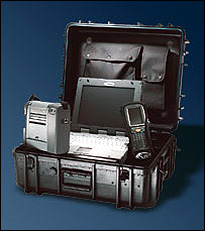A year and a half after the U.S. Marine Corps placed orders for Savi Technologies’ Portable Deployment Kit (PDK), the system is now being used by most of the nation’s military branches for improved supply chain management. The PDK contains a handheld or fixed RFID interrogator with a foldout antenna and an Iridium Satellite 9601 Short Burst Data modem.
The U.S. Department of Defense (DOD) is currently using about 300 PDKs. The Army plans to equip all Movement Control Battalions and Movement Control Teams—tactical units responsible for convoy and movement management for deploying and sustaining Army units—with PDK capability. In addition, the Army National Guard is analyzing requirements to use the technology in support of civil affairs missions.
“It is currently being used to track shipments, build and manage convoys, and provide mobile operational support to civil emergencies,” says Alan Estevez, principal assistant deputy undersecretary of defense (logistics and materiel readiness). “The current fielded PDKs are functioning properly and meeting DOD’s requirement to provide asset visibility in austere/mobile environments.”
Packaged as a 56-pound “suitcase,” the system also incorporates a GPS location system, a laptop computer, a power bus and a label printer for creating military shipping labels. The interrogator reads active RFID tags attached to weapons, vehicles and other military assets at 433.92 MHz, and complies with the ISO 18000-7 air-protocol standard. It can be taken into the field for military use, and is designed to withstand a drop of up to 4 feet.
The PDK can be utilized in multiple applications, depending on the software installed, Estevez explains, but its basic capability is to let users quickly set up a mobile site to collect active RFID tag data and report that data to visibility systems using the Iridium modem. The PDKs are not being employed to read or encode passive EPC RFID tags, says Greg Ewert, Iridium’s executive vice president, but could be augmented to do so if needed. Although Savi intends to add multimodal handhelds for passive RFID in future PDKs, there is no specific timetable for doing so at present.
With the PDK, the military can track the movement of weapons, vehicles and other supplies. A fixed reader can be temporarily set up at a position where supplies are trucked through, or where incoming supplies are unloaded from a plane. The PDK’s handheld reader can be carried into areas where inventory counts are needed and, upon return to the kit, be connected to the modem so it can transmit the collected information to a DOD server.
The PDK was developed by Savi Technologies in 2005, based on the needs of the U.S. military (see Portable Kit Enables Remote Tracking). “They had a need for a self-contained unit with no fixed infrastructure for power or communications,” says Savi’s David Stephens, senior vice president, public sector. The military was already using the Iridium modem for satellite communications, which is why Savi developed the PDK with the Iridium 9601 modem built in.
Savi personnel visited locations in Iraq to test the PDK system as recently as this past fall, when the company added new capabilities to the PDK platform. Those capabilities included the Savi Manifest Application (SMA) enabling cargo and vehicles to be associated with each other on the In-Transit Visibility (ITV) server.
“We are continuously working to expand user functional applications to increase the operational efficiencies of the service management systems using the standard PDK platform,” Stephens says.
Iridium recently signed a contract with the U.S. military for its 9601 Short Burst Data (SBD) modem to be included on the department’s list of standard equipment. It can be sold to any agency within the DOD, with or without the accompanying PDK. The modem can be connected to Bluetooth, ZigBee or ultrawide-band (UWB) devices, Ewert says, as well as to RFID readers.



